brake TOYOTA AVALON 2017 XX40 / 4.G Owners Manual
[x] Cancel search | Manufacturer: TOYOTA, Model Year: 2017, Model line: AVALON, Model: TOYOTA AVALON 2017 XX40 / 4.GPages: 492, PDF Size: 7.17 MB
Page 3 of 492

3
1
8 7
6
5
4
3
2
9
4-1. Before drivingDriving the vehicle ............. 144
Cargo and luggage............ 154
Vehicle load limits ............. 157
Trailer towing..................... 158
Dinghy towing.................... 159
4-2. Driving procedures Engine (ignition) switch .............................. 160
Automatic transmission .................... 165
Turn signal lever................ 171
Parking brake .................... 172
4-3. Operating the lights and wipers
Headlight switch ................ 173
Automatic High Beam ....... 176
Windshield wipers and washer ..................... 180
4-4. Refueling Opening the fuel tank cap .......................... 186 4-5. Using the driving
support systems
Toyota Safety Sense P ...... 190
PCS (Pre-Collision System)..... 198
LDA (Lane Departure Alert
with steering control) ....... 211
Dynamic radar cruise control.............................. 222
Cruise control .................... 235
BSM (Blind Spot Monitor)......... 239
• The Blind Spot Monitor function............. 241
• The Rear Cross Traffic Alert function ................. 245
Driving mode select switches........................... 248
Driving assist systems ....... 250
4-6. Driving tips Winter driving tips .............. 255
4Driving
Page 9 of 492
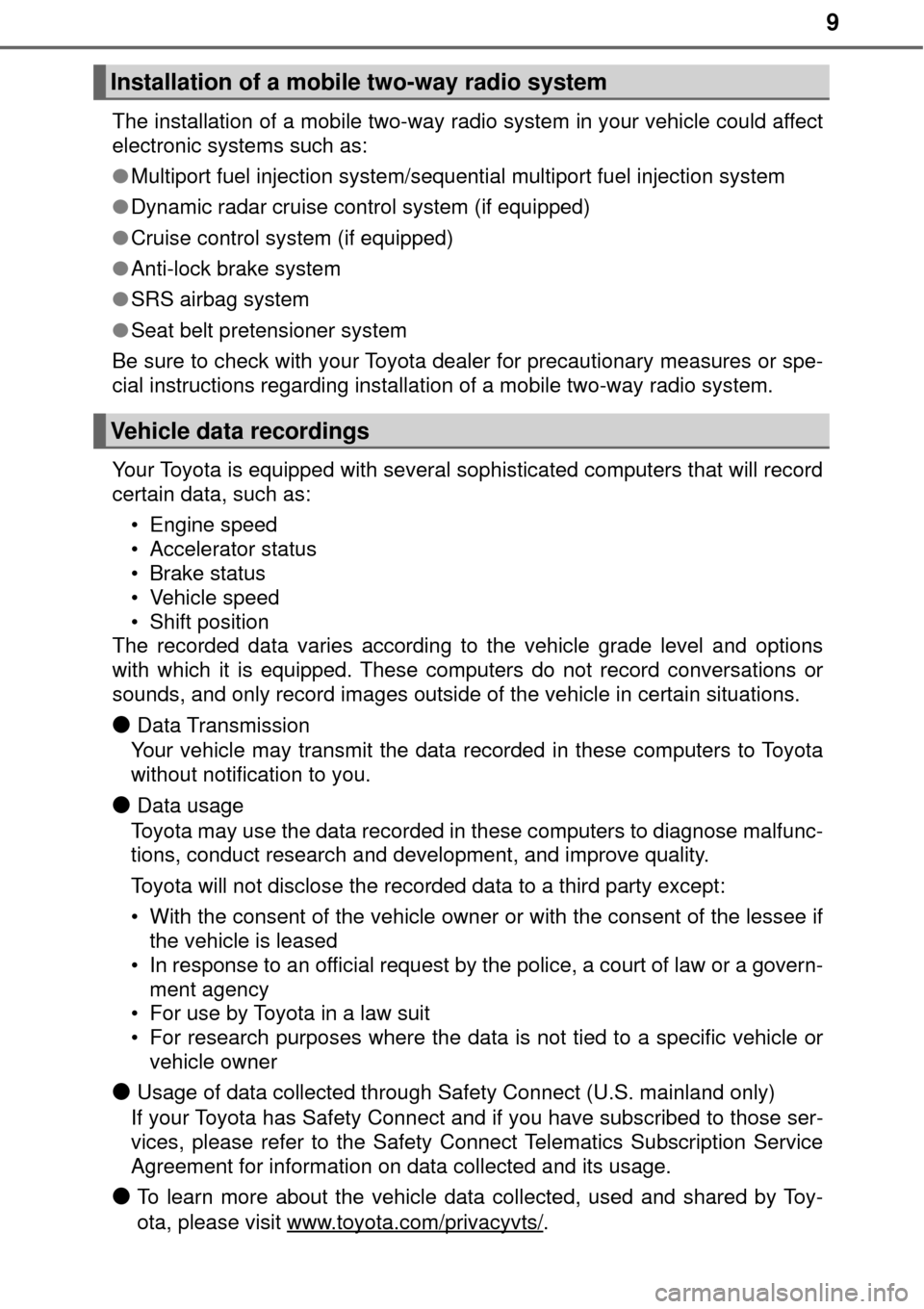
9
The installation of a mobile two-way radio system in your vehicle could affect
electronic systems such as:
●Multiport fuel injection system/sequential multiport fuel injection system
● Dynamic radar cruise control system (if equipped)
● Cruise control system (if equipped)
● Anti-lock brake system
● SRS airbag system
● Seat belt pretensioner system
Be sure to check with your Toyota dealer for precautionary measures or spe-
cial instructions regarding installation of a mobile two-way radio system.
Your Toyota is equipped with several sophisticated computers that will record
certain data, such as:
• Engine speed
• Accelerator status
• Brake status
• Vehicle speed
• Shift position
The recorded data varies according to the vehicle grade level and options
with which it is equipped. These computers do not record conversations or
sounds, and only record images outside of the vehicle in certain situati\
ons.
●Data Transmission
Your vehicle may transmit the data re corded in these computers to Toyota
without notification to you.
●Data usage
Toyota may use the data recorded in these computers to diagnose malfunc-
tions, conduct research and development, and improve quality.
Toyota will not disclose the recorded data to a third party except:
• With the consent of the vehicle owner or with the consent of the lessee if the vehicle is leased
• In response to an official request by the police, a court of law or a govern-
ment agency
• For use by Toyota in a law suit
• For research purposes where the data is not tied to a specific vehicle or
vehicle owner
●Usage of data collected through Safety Connect (U.S. mainland only)
If your Toyota has Safety Connect and if you have subscribed to those ser-
vices, please refer to the Safety Connect Telematics Subscription Service
Agreement for information on data collected and its usage.
●To learn more about the vehicle data collected, used and shared by Toy-
ota, please visit www.toyota.com/privacyvts/
.
Installation of a mobile two-way radio system
Vehicle data recordings
Page 10 of 492

10
This vehicle is equipped with an event data recorder (EDR). The main pur-
pose of an EDR is to record, in certain crash or near crash-like situations,
such as an air bag deployment or hitting a road obstacle, data that will assist
in understanding how a vehicle’s systems performed. The EDR is designed to
record data related to vehicle dynamics and safety systems for a short period
of time, typically 30 seconds or less.
The EDR in this vehicle is designed to record such data as:• How various systems in your vehicle were operating;
• Whether or not the driver and passenger safety belts were buckled/fas-tened;
• How far (if at all) the driver was depressing the accelerator and/or brake pedal; and,
• How fast the vehicle was traveling.
These data can help provide a better understanding of the circumstances in
which crashes and injuries occur.
NOTE: EDR data are recorded by your vehicle only if a non-trivial crash situ-
ation occurs; no data are recorded by the EDR under normal driving condi-
tions and no personal data (e.g., name, gender, age, and crash location) are
recorded. However, other parties, such as law enforcement, could combine
the EDR data with the type of personally identifying data routinely acquired
during a crash investigation.
To read data recorded by an EDR, special equipment is required, and access
to the vehicle or the EDR is needed. In addition to the vehicle manufacturer,
other parties, such as law enforcement, that have the special equipment, can
read the information if they have access to the vehicle or the EDR.
●Disclosure of the EDR data
Toyota will not disclose the data recorded in an EDR to a third party except
when:
• An agreement from the vehicle’s owner (or the lessee for a leased vehi- cle) is obtained
• In response to an official request by the police, a court of law or a govern- ment agency
• For use by Toyota in a lawsuit
However, if necessary, Toyota may:
• Use the data for research on vehicle safety performance
• Disclose the data to a third party for research purposes without disclosing information about the specific vehicle or vehicle owner
Event data recorder
Page 20 of 492
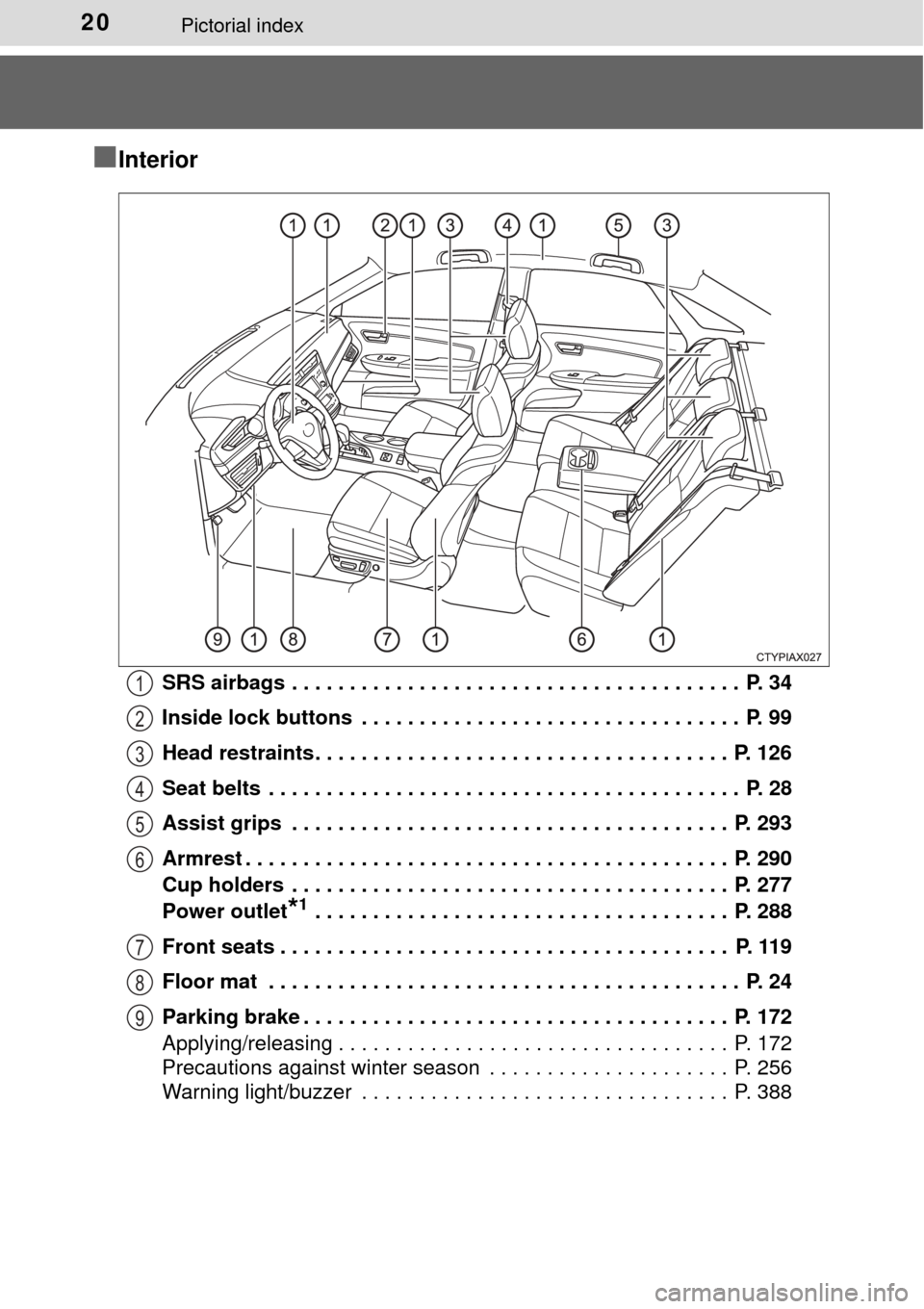
20Pictorial index
■Interior
SRS airbags . . . . . . . . . . . . . . . . . . . . . . . . . . . . . . . . . . . . . . . P. 34
Inside lock buttons . . . . . . . . . . . . . . . . . . . . . . . . . . . . . . . . . P. 99
Head restraints . . . . . . . . . . . . . . . . . . . . . . . . . . . . . . . . . . . . P. 126
Seat belts . . . . . . . . . . . . . . . . . . . . . . . . . . . . . . . . . . . . . . . . . P. 28
Assist grips . . . . . . . . . . . . . . . . . . . . . . . . . . . . . . . . . . . . . . P. 293
Armrest . . . . . . . . . . . . . . . . . . . . . . . . . . . . . . . . . . . . . . . . . . P. 290
Cup holders . . . . . . . . . . . . . . . . . . . . . . . . . . . . . . . . . . . . . . P. 277
Power outlet
*1 . . . . . . . . . . . . . . . . . . . . . . . . . . . . . . . . . . . . P. 288
Front seats . . . . . . . . . . . . . . . . . . . . . . . . . . . . . . . . . . . . . . . P. 119
Floor mat . . . . . . . . . . . . . . . . . . . . . . . . . . . . . . . . . . . . . . . . . P. 24
Parking brake . . . . . . . . . . . . . . . . . . . . . . . . . . . . . . . . . . . . . P. 172
Applying/releasing . . . . . . . . . . . . . . . . . . . . . . . . . . . . . . . . . . P. 172
Precautions against winter season . . . . . . . . . . . . . . . . . . . . . P. 256
Warning light/buzzer . . . . . . . . . . . . . . . . . . . . . . . . . . . . . . . . P. 388
1
2
3
4
5
6
7
8
9
Page 75 of 492
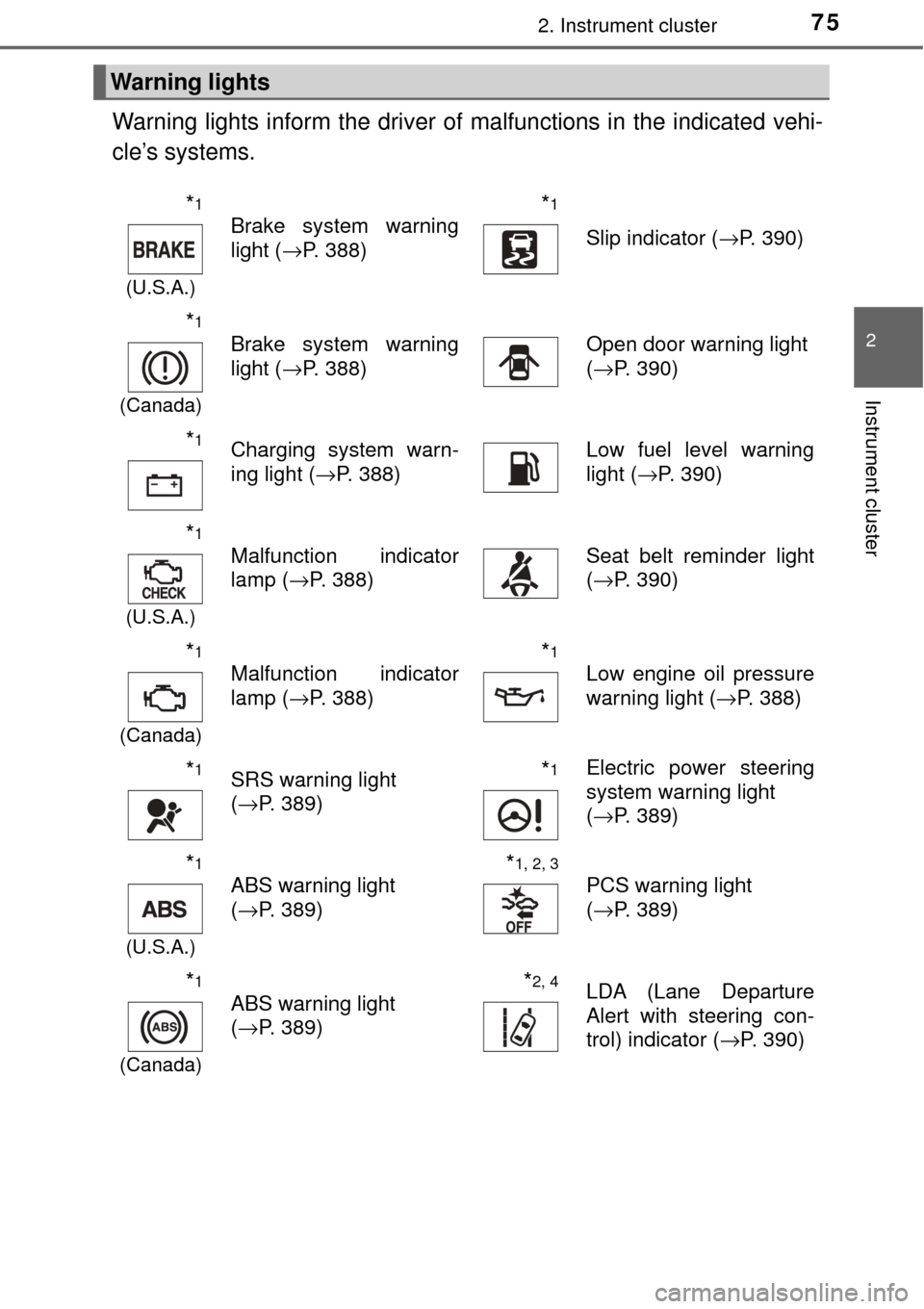
752. Instrument cluster
2
Instrument cluster
Warning lights inform the driver of malfunctions in the indicated vehi-
cle’s systems.
Warning lights
*1
(U.S.A.)
Brake system warning
light ( →P. 388)*1
Slip indicator ( →P. 390)
*1
(Canada)
Brake system warning
light (→P. 388)Open door warning light
(→P. 390)
*1Charging system warn-
ing light ( →P. 388)Low fuel level warning
light (→P. 390)
*1
(U.S.A.)
Malfunction indicator
lamp ( →P. 388)Seat belt reminder light
(→P. 390)
*1
(Canada)
Malfunction indicator
lamp ( →P. 388)*1
Low engine oil pressure
warning light ( →P. 388)
*1SRS warning light
(→P. 389)*1Electric power steering
system warning light
(→P. 389)
*1
(U.S.A.)
ABS warning light
(→P. 389)*1, 2, 3
PCS warning light
(→P. 389)
*1
(Canada)
ABS warning light
(→P. 389)*2, 4LDA (Lane Departure
Alert with steering con-
trol) indicator ( →P. 390)
Page 112 of 492
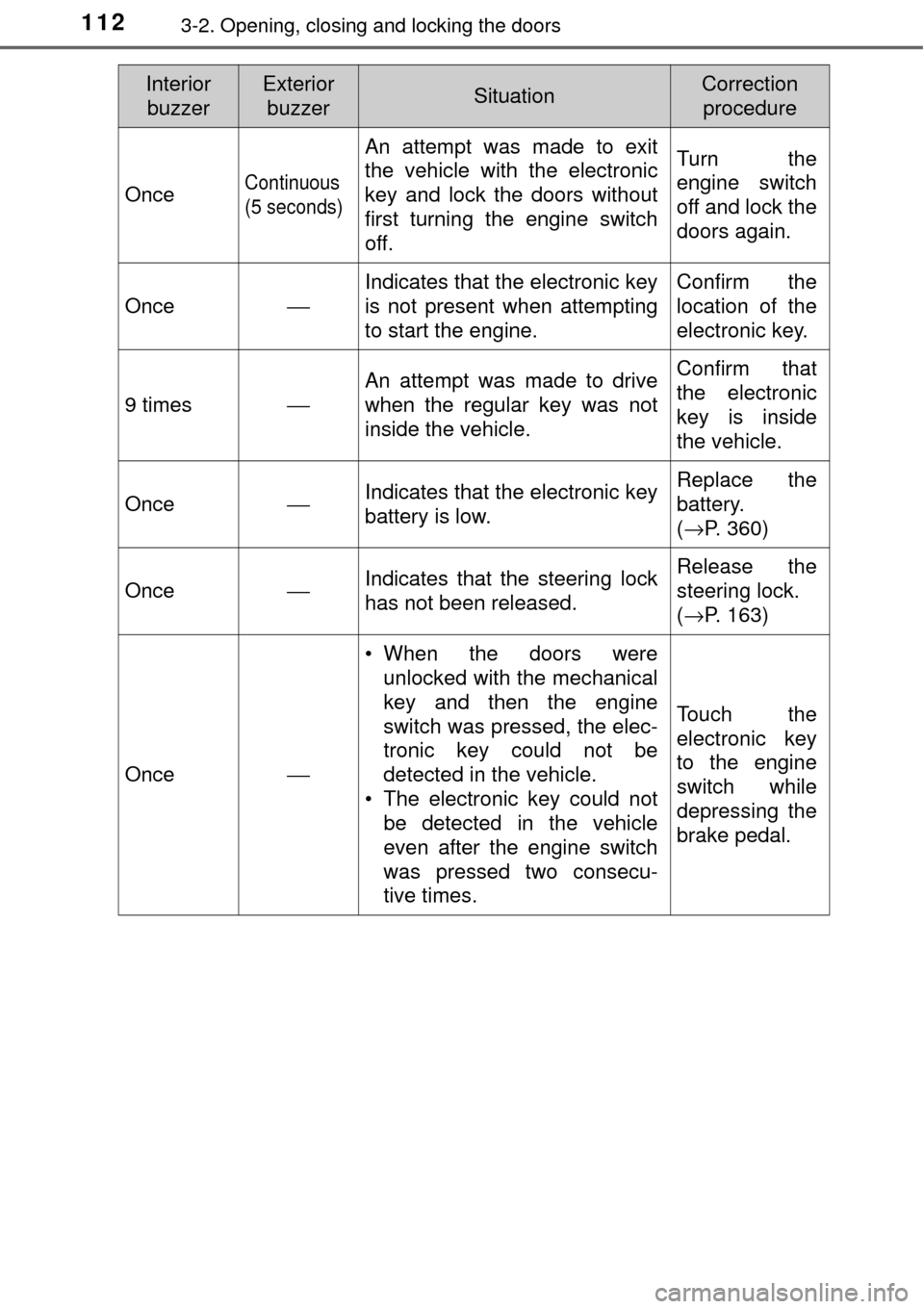
1123-2. Opening, closing and locking the doors
OnceContinuous
(5 seconds)
An attempt was made to exit
the vehicle with the electronic
key and lock the doors without
first turning the engine switch
off.Turn the
engine switch
off and lock the
doors again.
Once
⎯ Indicates that the electronic key
is not present when attempting
to start the engine. Confirm the
location of the
electronic key.
9 times⎯
An attempt was made to drive
when the regular key was not
inside the vehicle.Confirm that
the electronic
key is inside
the vehicle.
Once⎯Indicates that the electronic key
battery is low.Replace the
battery.
(
→P. 360)
Once⎯Indicates that the steering lock
has not been released.Release the
steering lock.
(→P. 163)
Once⎯
• When the doors were
unlocked with the mechanical
key and then the engine
switch was pressed, the elec-
tronic key could not be
detected in the vehicle.
• The electronic key could not be detected in the vehicle
even after the engine switch
was pressed two consecu-
tive times.
Touch the
electronic key
to the engine
switch while
depressing the
brake pedal.
InteriorbuzzerExterior buzzerSituationCorrection procedure
Page 143 of 492

143
Driving4
4-1. Before drivingDriving the vehicle ............. 144
Cargo and luggage ........... 154
Vehicle load limits ............. 157
Trailer towing..................... 158
Dinghy towing ................... 159
4-2. Driving procedures Engine (ignition) switch .............................. 160
Automatic transmission .................... 165
Turn signal lever................ 171
Parking brake .................... 172
4-3. Operating the lights and wipers
Headlight switch ................ 173
Automatic High Beam ....... 176
Windshield wipers and washer ............................ 180
4-4. Refueling Opening the fuel tank cap .......................... 186 4-5. Using the driving
support systems
Toyota Safety Sense P ..... 190
PCS (Pre-Collision
System)........................... 198
LDA (Lane Departure Alert
with steering control) ....... 211
Dynamic radar cruise control ............................. 222
Cruise control .................... 235
BSM (Blind Spot Monitor) ........ 239
• The Blind Spot Monitor function ............ 241
• The Rear Cross Traffic Alert
function ......................... 245
Driving mode select switches .......................... 248
Driving assist systems ...... 250
4-6. Driving tips Winter driving tips ............. 255
Page 144 of 492
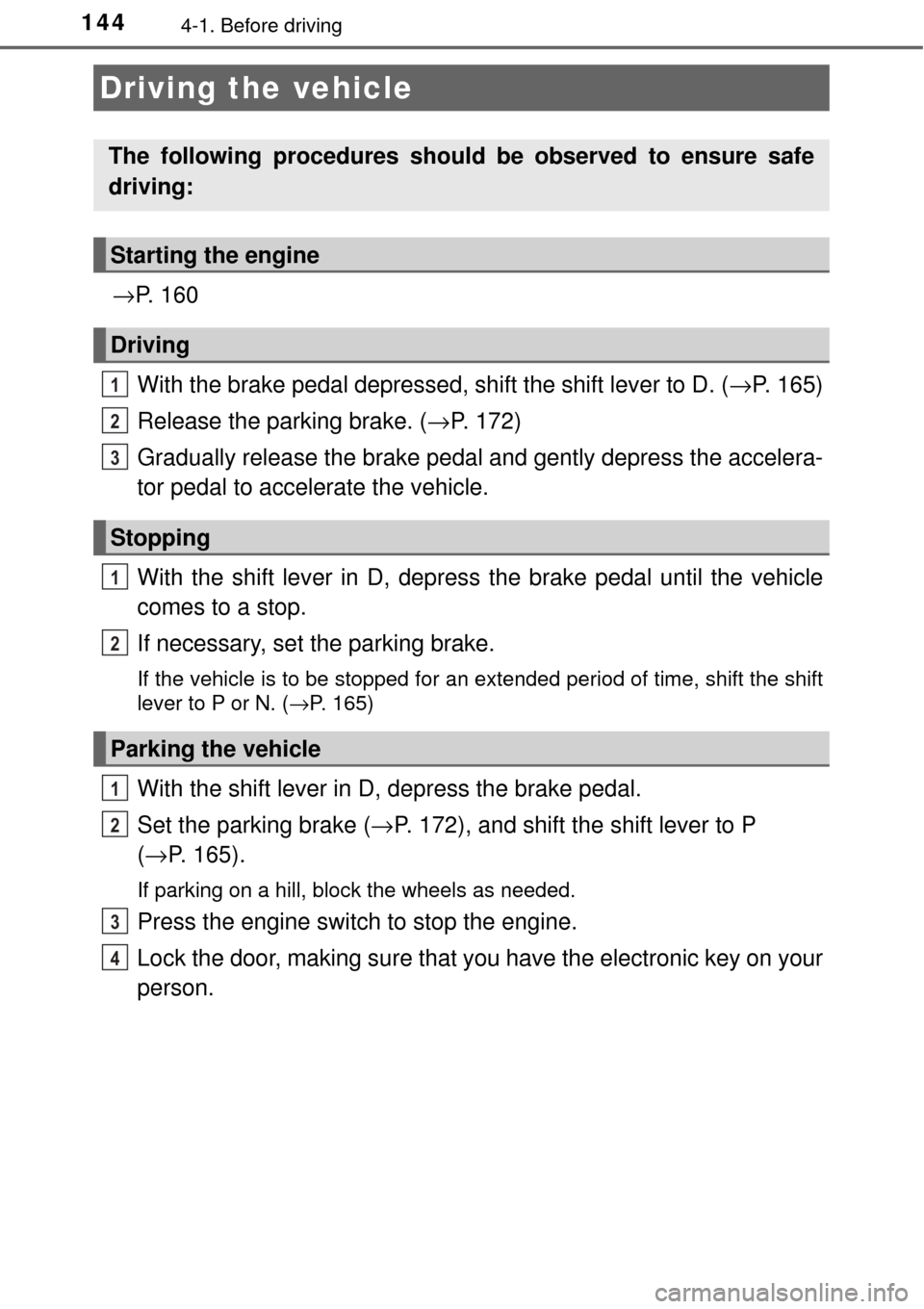
1444-1. Before driving
→P. 1 6 0
With the brake pedal depressed, shift the shift lever to D. ( →P. 165)
Release the parking brake. ( →P. 172)
Gradually release the brake pedal and gently depress the accelera-
tor pedal to accelerate the vehicle.
With the shift lever in D, depress the brake pedal until the vehicle
comes to a stop.
If necessary, set the parking brake.
If the vehicle is to be stopped for an extended period of time, shift the shift
lever to P or N. ( →P. 165)
With the shift lever in D, depress the brake pedal.
Set the parking brake ( →P. 172), and shift the shift lever to P
( → P. 165).
If parking on a hill, block the wheels as needed.
Press the engine switch to stop the engine.
Lock the door, making sure that you have the electronic key on your
person.
Driving the vehicle
The following procedures should be observed to ensure safe
driving:
Starting the engine
Driving
Stopping
Parking the vehicle
1
2
3
1
2
1
2
3
4
Page 145 of 492

1454-1. Before driving
4
Driving
Make sure that the parking brake is set and shift the shift lever to D.
Gently depress the accelerator pedal.
Release the parking brake.
■Driving in the rain
●Drive carefully when it is raining, because visibility will be reduced, the win-
dows may become fogged-up, and the road will be slippery.
● Drive carefully when it starts to rain, because the road surface will be espe-
cially slippery.
● Refrain from driving at high speeds in the rain, as there may be a layer of
water between the tires and the road surface, preventing the steering and
brakes from operating properly.
■ Engine speed while driving
In the following conditions, the engine speed may become high while driving.
This is due to automatic up-shifting control or down-shifting implementation to
meet driving conditions. It does not indicate sudden acceleration.
●The vehicle is judged to be driving uphill or downhill
● When the accelerator pedal is released
Starting off on a steep uphill
1
2
3
Page 146 of 492

1464-1. Before driving
■Breaking in your new Toyota
To extend the life of the vehicle, observing the following precautions is recom-
mended:
●For the first 186 miles (300 km):
Avoid sudden stops.
● For the first 621 miles (1000 km):
• Do not drive at extremely high speeds.
• Avoid sudden acceleration.
• Do not drive continuously in low gears.
• Do not drive at a constant speed for extended periods.
■ Drum-in-disc type parking brake system
Your vehicle has a drum-in-disc type par king brake system. This type of brake
system needs bedding-down of the brake shoes periodically or whenever the
parking brake shoes and/or drum are replaced. Have your Toyota dealer per-
form the bedding down operation.
■ Operating your vehicle in a foreign country
Comply with the relevant vehicle registration laws and confirm the availability
of the correct fuel. ( →P. 433)
WARNING
Observe the following precautions.
Failure to do so may result in death or serious injury.
■When starting the vehicle
Always keep your foot on the brake pedal while stopped with the engine
running. This prevents the vehicle from creeping.
■ When driving the vehicle
● Do not drive if you are unfamiliar with the location of the brake and ac\
cel-
erator pedals to avoid depressing the wrong pedal.
• Accidentally depressing the accelerator pedal instead of the brake
pedal will result in sudden acceleration that may lead to an accident.
• When backing up, you may twist your body around, leading to a diffi- culty in operating the pedals. Make sure to operate the pedals properly.
• Make sure to keep a correct driving posture even when moving the
vehicle only slightly. This allows you to depress the brake and accelera-
tor pedals properly.
• Depress the brake pedal using your right foot. Depressing the brake
pedal using your left foot may delay response in an emergency, result-
ing in an accident.
● Do not drive the vehicle over or stop the vehicle near flammable materials.
The exhaust system and exhaust gases can be extremely hot. These hot
parts may cause a fire if there is any flammable material nearby.